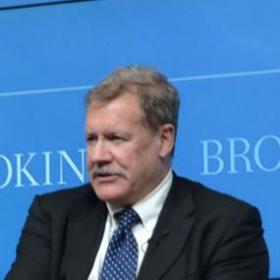
NATO Should Hand Over in Afghanistan
Greg Austin wrote this piece for his weekly column in New Europe.
In August 2003, NATO took over the leadership of the International Security Assistance Force (ISAF) in Afghanistan under the mandate of the United Nations. As the ISAF website notes: “The Alliance became responsible for the command, coordination and planning of the force.”
But who is running this Alliance? Where is the Allied command at political level that binds together these allies around a political strategy agreed by all of the Allies? According to ISAF, the North Atlantic Council (NAC) “provides overall coordination and political direction”, working “in close consultation” with non-NATO troop-contributing countries. The NAC meets at least weekly, often more frequently, at Ambassadorial level in Brussels, and twice yearly at Ministerial level, and occasionally at Head of State level. Is the NAC really making the political command decisions for the counter-insurgency war in Afghanistan? Should it be?
The answer is no, on both counts. The NAC is not and cannot be a supreme decision making body for the politics of war inside Afghanistan. This gap in political control and accountability for war waged by the international community needs to be fixed.
Everyone accepts the need for a clear transition from the massive intervention by NATO and other allies to a politically sustainable future premised on a self-confident and secure Afghanistan. To do this, we need a new (a genuine) political command council that is dominated not just by a handful of NATO members but by the key political players in the war, of which the Afghanistan government has to be one.
Because support from inside NATO for Afghan combat operations is weakening, the UN Allies and the NAC need to think rather urgently about creating a new structure that provides for a durable, representative and workable political command. The United States has been the pre-eminent policy designer for NATO in this war (and still runs its own independent forces in Afghanistan) but it is not a credible long-term leader for the political transition we now need. The United States, like NATO, has to pass the baton, but to whom and to what?
The answer may lie in how the main actors address the need for a second requirement: effective regional security arrangements that can counter the violent extremists using Islam as their cover. That problem has to be solved primarily by Muslim states and Muslim communities.
The only answer may be to create a new standing Council at head of state level that brings together key stakeholders from the region and the major external powers. It might comprise the UN Secretary General (as chair), Afghanistan, Pakistan, UAE, Saudi Arabia, the Secretary General of the Organization of Islamic Conference (OIC), the United States, the European Union, Russia, China and India. There would have to be a place for Iran at the table. This Council would not be a command authority for Afghanistan alone, but a political stabilization council and allied command authority for the South and West Asia regions.
The Council could devise, fund and execute a clear set of complementary political, military and economic action plans for these regions in their entirety, even if discrete elements might need to be packaged country by country according to political sensitivities and practicalities. These measures could include a Muslim Peace Corps building on the OIC’s youth initiative from 2003. The Council could serve under UN mandate for renewable periods.
This might be a path marked by controversy, division and failures, but it is the only sustainable path. Such a step would serve to force the pace on regional security cooperation in a part of the world where it is so embryonic, so mistrusted and so visibly needed.

